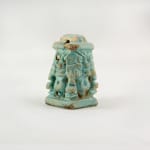New Kingdom Faience Amulet of Bes, 1600 BCE - 600 BCE
Faience
3.5 x 2.2 cm
1 3/8 x 7/8 in
1 3/8 x 7/8 in
PF.2983
Further images
Bes was one of the most popular gods in the Egyptian pantheon; he was believed to be a patron god of music and art as well as a protector of...
Bes was one of the most popular gods in the Egyptian pantheon; he was believed to be a patron god of music and art as well as a protector of pregnant women. He was also held to be a god of war. It was in this guise that he is frequently depicted in the Greco-Roman world. He is usually depicted as a dwarf with a face that is both leonine and human. Greco-Roman period images of the god, however, frequently show him as a more heroic looking figure brandishing a sword while on horseback. Bes was a very popular subject for amulets and appears to have been widely worshipped as a household deity. It seems that he was believed to be an easily accessible god who would benevolently listen to the prayers of the common man. He was not perceived to be as intimidating as the state gods such as Amun, Osiris, or Horus. This unique blue faience amulet depicts the god Bes as a squatting dwarf with his hands upon his knees. The most interesting feature of this sculpture is the four-sided frontal representation, which may indicate that the artist was trying to show Bes as being omniscient and ever watchful.





